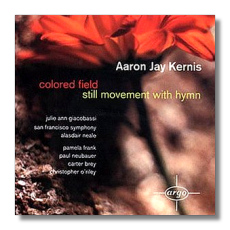
The Internet's Premier Classical Music Source
Related Links
- Kernis Reviews
- Latest Reviews
- More Reviews
-
By Composer
-
Collections
DVD & Blu-ray
Books
Concert Reviews
Articles/Interviews
Software
Audio
Search Amazon
Recommended Links
Site News
 CD Review
CD Review
Aaron Jay Kernis

- Colored Field 1
- Still Movement with Hymn 2
1 Julie Ann Giacobassi, English horn
1 San Francisco Symphony Orchestra/Alasdair Neale
2 Pamela Frank, violin
2 Paul Neubauer, viola
2 Carter Brey, cello
2 Christopher O'Riley, piano
Argo 448174-2 DDD 70:37
If Aaron Jay Kernis wasn't even thirty-five when he finished Colored Field, what will he write when he's twice that age? Even people who normally are resistant to modern classical music must succumb to its drama and its emotional sincerity, and appreciate its fine craftsmanship.
The San Francisco Symphony asked Kernis for a concerto for English horn (good choice - there isn't enough concertante music for this attractive instrument), and that's what Kernis gave them, although I wonder if the individuals who awarded the commission were aware of what an overwhelming piece they were going to get. It's true that the English horn is associated with pastoral pipings, but it also has been associated with Death - for example, the song of the Swan of Tuonela in Sibelius's Four Legends from the Kalevala. Several years ago, Kernis visited the remains of the death-camps at Auschwitz and Birkenau. While he was there, he saw a young American boy with his family. Kernis was struck by the contrast between the modern image of the boy sitting on the ground and chewing blades of grass, and the historical image of what had happened on that same soil just five decades earlier. These contrasting images inspired Kernis as he wrote his concerto.
Colored Field is in three movements: "Colored Field," "Pandora Dance," and "Hymns and Tablets." The English horn is very much the protagonist throughout, as the orchestra assails it, pities it, challenges it, weeps with it, and, in several very frightening passages, erases it from the landscape. The music expresses spiritual concerns, but not just those that are relevant to the Jewish faith and culture, despite allusions to liturgical music, and to klezmer and other folk music from Eastern Europe. When modern composers put their spiritual cards on the table, it seems to bring out the best in them. For example, I am thinking of James MacMillan, whose music Colored Field at times resembles. A forty-minute English horn concerto might sound like a bit of a stretch, but I assure you that Colored Field is absolutely riveting.
I recommend that you don't listen to Still Movement with Hymn, a non-traditional piano quartet, immediately after listening to Colored Field; its more severe style demands a fresh pair of ears. This is especially true because of its monolithic twenty-four minute first movement. As with Colored Field, its mood is elegiac, but this is much more private music, and it will take listeners a longer time to absorb it. At least this was the case for me.
Copyright © 1998, Raymond Tuttle


















